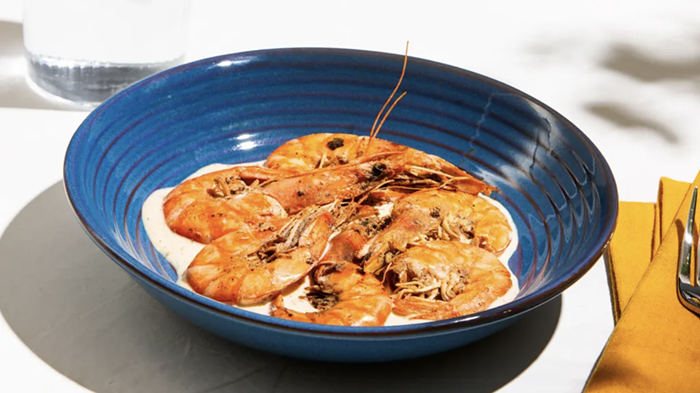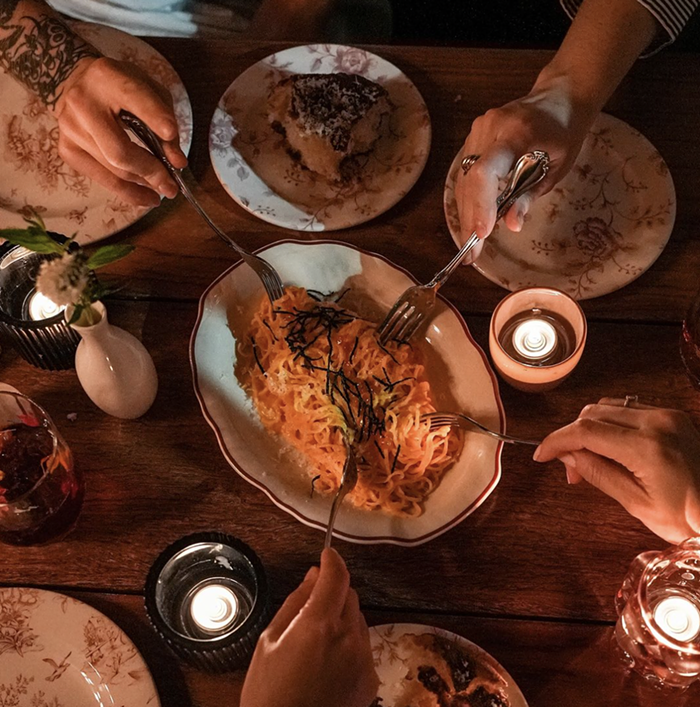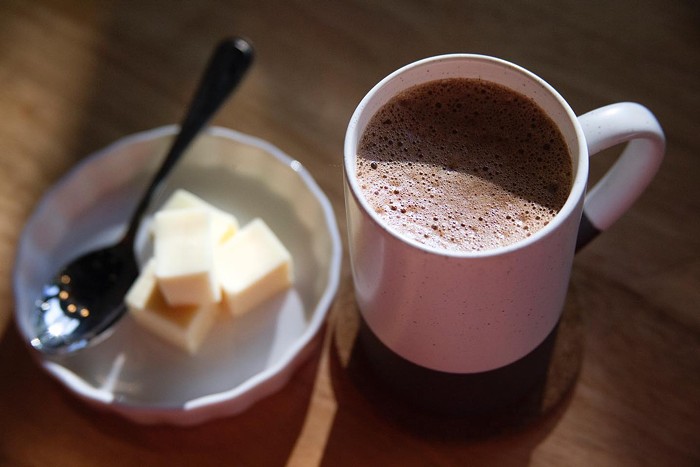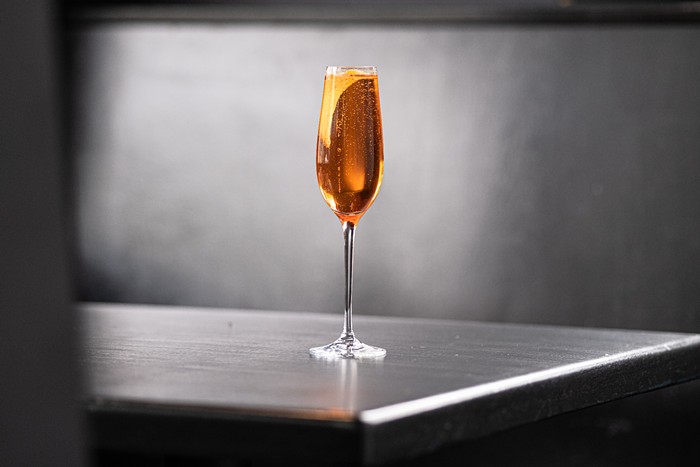The first time I tried to go to Pop Pop Thai Street Food, I drove right past it. It's located in a strip mall on Aurora, tucked between a Jimmy John's and a T-Mobile store, across the parking lot from an LA Fitness. The only hint that it's an anomaly in its surroundings, that it's not part of any corporate chain, is its sign: a black silhouette of a plane headed away from Thailand—the land of temples, tuk tuks, elephants, and palm trees—and toward the Emerald City skyline.
Pop Pop doesn't face the street; its front wall of windows looks out onto the LA Fitness, with a sea of parked cars between them. But whatever sunlight there is in Seattle reflects off those vehicles and in through the windows onto bright blue walls and one made of worn, salvaged wood. Pop Pop feels warm and personal—almost defiantly so—in spite of its sterile surroundings.
From my first bite of papaya salad ($9.95), I had a very good feeling. It's a lovingly composed heap of shredded green papaya, crisp long beans, cherry tomatoes, roasted peanuts, and finely diced Thai bird chilies tossed in a pungent spicy-and-sweet tamarind dressing. You can get it with dried shrimp ("original Thai style") or with fresh prawns, but skip those in favor of the version with salted crab, which comes scattered with the broken limbs and carapaces of the tiny purple crustaceans. You'll need to crack through the shells and slurp out the little bits of salty, gelatinous meat. But it's worth it: The flavor is incredible—briny and funky, as though the crabs journeyed straight from the dark, primordial depths of the sea to your table—and perfectly contrasts the salad's freshness and acidity.
While perusing the rest of the menu, I asked my server, Sara (who I later discovered is one of the Pop Pop's three owners), if the restaurant had any specialties. Without hesitation, she replied, "Number 12." She paused and, grinning, added, "Number six, too."
"Number 12" goes by the thoroughly boring name of "grilled chicken," but the dish itself is extraordinary—a version of kai yang ($9.95), a ubiquitous Isaan (Northern Thai) and Laotian street food of chicken cooked over charcoal. At Pop Pop, they use skin-on thigh meat (think: moist) that's been marinated in coconut milk (think: even moister). The chicken is also rubbed with a thick paste of lemongrass, garlic, and spices, which works its way deep into the meat's crevices and under its skin before hitting the grill, where it acquires a smoky flavor and great, caramelized char.
A mini bamboo basket filled with sticky rice comes with the chicken, rendering silverware irrelevant. Scoop the rice with your fingers, pick up some meat, then dip the combination into the accompanying brown sauce. There's an orange sweet chili sauce on the plate, too (the kind that comes from a bottle), but ignore that one and focus on the brown sauce: bold and salty, earthy and astringent, with a generous dusting of white pepper on its surface. It is marvelous. I am obsessed with it.
I wanted to know exactly what is in this sauce, so I asked Sara. At first she was reluctant to tell me, waving her hand nicely but dismissively while saying, "Oh, you know, Thai people. We like to dip things in sauces with many ingredients."
I do know, as my people, Filipinos, are dedicated to mixing up sawsaw (dips made of different combinations of ingredients like fish sauce, soy sauce, vinegar, chilies, and garlic) and offering them alongside dishes so that people can flavor each bite according to individual taste. They have the power to enhance a dish, elevating something good into something great. I pressed on.
"Is there lime juice?" I asked.
"Well, yes," she replied with a smile.
"Fish sauce?"
"Yes." This time her smile was bigger. I held the silence, and after a few seconds she relented a bit. "There is also sweet soy sauce and chilies. And a few other things." She smiled coyly.
Pop Pop excels in the sauce department. The one that accompanies "number six"—skin-on pork leg braised for hours in both dark and thin soy sauces, palm sugar, and Chinese five-spice powder ($9.95)—uses vinegar, cilantro, green chilies, and fish sauce to lighten and brighten the richness of the stewed meat. Simply steamed kai-lan (Chinese broccoli) and crunchy pickled mustard greens also balance out the dish.
The dipping sauce that comes alongside kao mun gai ($8.95), a Thai version of Hainanese chicken, is the highlight of what might be an otherwise bland dish. Hainanese chicken is traditionally very simple—chicken poached in a garlic and ginger broth, then served with rice that's prepared in that cooking liquid—and Pop Pop's is no different. But its deep brown sauce, made from reduced fermented soybean paste and plenty of chopped garlic, ginger, and Thai chilies, is thrilling, turning a dish I've had dozens of times into something entirely new.
Pop Pop is proud to serve things that, in Sara's words, "you don't see at other Thai places. Something different." Like the braised pork leg. Or the red sea noodle soup ($9.95)—wide rice noodles cooked in a bright, rose-colored broth, with morning glory greens, fresh shrimp, fried tofu, and assorted fish balls. The pinkness of the broth comes from the addition of fluorescent, salted soybean paste. Nearly everything about this dish was a revelation to me, in particular an ordinary-looking white fish ball that, when bitten into, burst open with tiny balls of squishy, yellow fish roe.
I have to mention that I found most of the food at Pop Pop a bit sweet for my taste. But, to the kitchen's credit, the dishes are never cloying. For every bit of sweetness, there's an equal amount of spice, salt, or tang—the food is always balanced.
Pop Pop, which has been open for four months, is owned by friends Eakpoj (Ken) Opilun and Itti Metiyawongse (who goes by the nickname Pop), as well as Pop's wife, Sajeephan Surapaitoolkorn (Sara). Ken and Pop have been friends for more than 10 years, having worked together as bartenders at clubs and bars around town.
The vision for Pop Pop was to "bring home cooking to our customers," says Ken. The three of them developed Pop Pop's recipes together, with a little help from Pop's mother and sister. The menu caters to customers who, as Ken says, "expect their food to be ready in 10 minutes," but also includes dishes that take hours to cook. "We also want to serve food that is real comfort food to us—what we would cook for ourselves on the weekends."
So far, Pop Pop seems to draw a regular lunch crowd of neighborhood workers. (The fact that nothing on Pop Pop's menu is priced above $9.95 must certainly help.) Most of the lunch orders seem to be for pad thai, garlic chicken, and curries. But the restaurant deserves a wider audience—diners who come for dinner and order the restaurant's harder-to-find specialties.
In the hallway that leads to the bathroom, Pop Pop has a bulletin board where customers and neighboring businesses can post flyers and business cards. In the lower left-hand corner is a handwritten card sent to the owners upon the restaurant's opening: "Wishing you all the success in everything, include good customers, plenty of cash flows. Am expecting to see a millionaire couple soon. Love, Mom."
I'm not sure anyone opens a restaurant to get rich. Most people are driven by a desire to share their food and culture. "We haven't done any marketing yet," Sara said as she asked me to tell my friends about the restaurant. "We are all here working seven days a week." ![]()


















